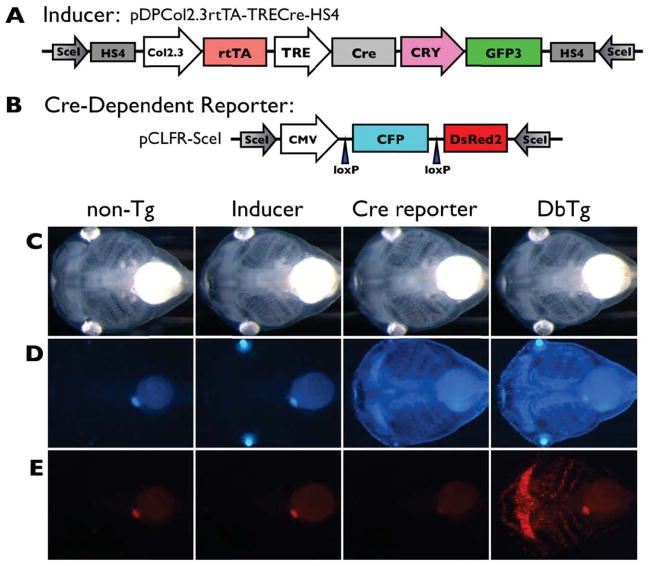Figure 1.
The Cre-dependent cartilage labeling system. A, B) This system uses an inducer transgenic line (pDPCol2.3rtTA-TRECre-HS4) that expresses Cre recombinase in cartilages to act on loxP sites in a Cre-reporter transgene in a second line (pCLFR-SceI)—resulting in DsRed2 replacing CFP in chondrocytes, thereby establishing DsRed2 expression in cartilage under control of the constitutive CMV promoter. The inducer line was designed for doxycycline (Dox) activation of Cre expression through the rtTA/TRE (TetOn) system. However, as shown in the next panel, col2a1 regulatory elements drive both rtTA and Cre expression, bypassing the TRE promoter and Dox control resulting in loss of inducible control. C, D, E) Inducer and Cre-reporter transgenic lines were crossed and two week-old tadpoles not treated with Dox are shown in bright field (C), blue (D), and red (E) fluorescent images. Double transgenics have both the inducer, revealed by GFP (green fluorescent protein) expression in the eyes driven by the lens-specific gamma crystallin (CRY) promoter, and the reporter, revealed by ubiquitous CFP (cyan fluorescent protein) driven by the CMV (cytomegalovirus) promoter. The four expected types of progeny were identified: 1) non-transgenic, 2) pCLFR-SceI single transgenics (CFP in the bodies), 3) pDPcol2.3rtTA-TRECre-HS4 single transgenics (GFP in the eyes, seen as a blue-green color in the blue images), and 4) double transgenics (GFP in the eyes and CFP in the body). Note that in the absence of Dox, DsRed2 fluorescence is visible in larval cartilages in double transgenic animals (E, right corner - see text for explanation).

